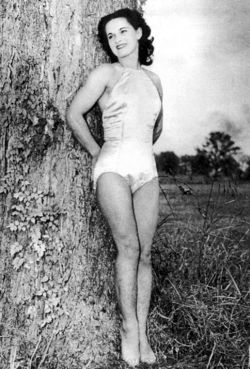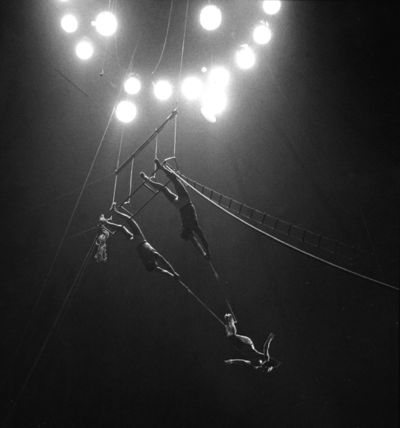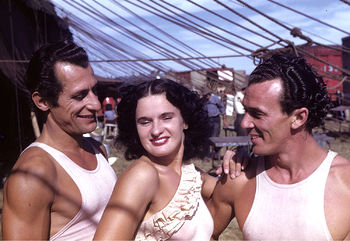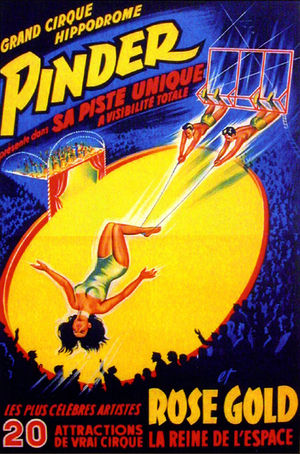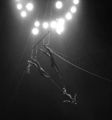Rose Gold
From Circopedia
Aerialist
By Dominique Jando
She was born Rosemarie Goldnagel in 1922 in Vienna, Austria. She didn’t belong to a circus family but she was a very physical and active child, and her parents made her study ballet and train in gymnastics. When Walt Disney released his animated movie, Snow White and The Seven Dwarfs in 1937, her father nicknamed Rosemarie, Snow White: Her opulent jay-black mane, which would become her most recognizable feature, made her look like the Disney character.
She was still a teenager when The Barlays, a German aerial act in search of a female partner, spotted her. Thus she started her circus career as one third of The 3 Barlays. And she was barely twenty when she met and fell in love with André Pahin, a French trapeze artist who worked with the famous bar-to-barA flying trapeze act in which flyers leap from a trapeze to another, instead of from a trapeze to a catcher as is most commonly seen today. flying actAny aerial act in which an acrobat is propelled in the air from one point to another. of The Zemgannos. WWII had already started when they met. Rosemarie was Austrian, and André was a French citizen: His country was part of the German occupied territories, and therefore he could work in the Axis countries should he choose to do so.
Circus folks are generally not much concerned by nationalities and international feuds—especially in Europe. André and Rosemarie created an aerial cradlePiece of apparatus (generally aerial) composed of two horizontal parallel bars in which a catcher locks his legs to be in position of catching a flyer. (Variant: Korean Cradle.) act together and debuted in 1943 at Cirkus Schumann in Copenhagen. Then Rosemarie gave birth to her and André’s son, André, Jr. (of whom nothing much is known), and a little later, the couple resumed work, appearing in Germany, Poland, and Czechoslovakia.
The war over, Germany lay in ruins and Eastern Europe was falling into the hands of Communist governments: Penniless, André and Rosemarie managed to flee to Paris, where they established residence. They finally got married and began to work on a new act with an original concept: A mixture of aerial cradlePiece of apparatus (generally aerial) composed of two horizontal parallel bars in which a catcher locks his legs to be in position of catching a flyer. (Variant: Korean Cradle.) and swinging trapeze, in which Rosemarie would work with two catchers holding her trapeze. They found a partner, Bernard Zenner, who had worked with a well-known aerial act, The Norbertys, and the trio went to train at the fabled Gymnase de la Cité du Midi—a training space in a small cul-de-sac opening on the Boulevard de Clichy where, in that pre-circus-school era, many circus artists trained and created new acts.
Enter Rose Gold
A number of circus performers who trained at the Cité du Midi lived in the neighborhood, which was at the foot of Montmartre and also encompassed the legendary Cirque Medrano—where they used to hang around to meet old friends contracted there for the month. The latter, in turn, visited them at the Cité du Midi, where Rosemarie’s exceptional skills and artistry, her daredevilry and her good looks had indeed been noticed. She and André needed money: The grapevine landed Rosemarie a one-month contract with a solo trapeze act (her new act was not ready yet) at the Cirque Medrano, for the opening show of the 1945-46 season in September.
She was billed Rose Gold. It had a good feel to it, was certainly catchier than Rosemarie Pahin—and Goldnagel would have indeed sounded a little too Teutonic to the recently liberated Parisians! Rose Gold was an instant sensation: her act was performed very high under the cupola, and included spectacular heel and toe hangs, which the gorgeous and graceful aerialistAny acrobat working above the ring on an aerial equipment such as trapeze, Roman Rings, Spanish web, etc. executed with a radiant smile and without any safety—her long, black hair waving with each of her moves. The audience fell in love, and so did the very savvy Parisian critics who unanimously announced the birth of a new star.The following month, Rose Gold was featured at the Théâtre de l’Étoile (one of Paris’s lost music-halls, which disappeared in 1964) in a show that starred the singer (and later, actor) Yves Montand; to some reviewers, Rose was at par with the star of the show, and they treated her as such. Jérôme Medrano knew star potential when he saw it: No later than late November 1945, Rose Gold and Co., as they were billed, were the headliners of the latest Medrano offering, in which they debuted their brand new act. (At the time, Medrano, the Cirque d’Hiver and Paris’s music-halls and cabarets, renewed their shows every three or four weeks!)
Performed to Franz Lehár’s Gold und Silber ("Gold and Silver") waltz, their act began with a series of classic aerial cradlePiece of apparatus (generally aerial) composed of two horizontal parallel bars in which a catcher locks his legs to be in position of catching a flyer. (Variant: Korean Cradle.) swings, with hands-to-feet catches and other similar moves, in which Rose worked in the hands of her two partners hanging side by side on an extended cradlePiece of apparatus (generally aerial) composed of two horizontal parallel bars in which a catcher locks his legs to be in position of catching a flyer. (Variant: Korean Cradle.). The second part of the act was far more spectacular: hanging from the cradlePiece of apparatus (generally aerial) composed of two horizontal parallel bars in which a catcher locks his legs to be in position of catching a flyer. (Variant: Korean Cradle.), she released herself and caught the bar of a trapeze hand-held below by her partners. Then they released the trapeze’s ropes to their full length and started swinging it. The swinging part included Rose’s back balancing, various hand and ankle catches, and ended in full swing with a spectacular heel hang, barefooted. As a finale, Rose jumped head first from the cradlePiece of apparatus (generally aerial) composed of two horizontal parallel bars in which a catcher locks his legs to be in position of catching a flyer. (Variant: Korean Cradle.), her ankles attached to two braided ropes that suddenly unfolded, and she ended swinging a few feet from the ground; the audience was left breathless!
The Rose Gold Trio’s performance was an unmitigated triumph. Once again the Parisian critics waxed lyrical; in Le Pays, Serge, the most popular of them, released all the flourishes of which his ornate prose was capable. He ended thus his review: "This petite brunette, without showing the least flinch of anxiety, always exhibiting this famous acrobatic smile that blossoms only in the flies, performs a series of very improbable exercises that are certain to gratify vertigo lovers everywhere. This act, with that of Les Clérans, is perhaps the most sensational we have seen in the Circus in the past five years…"
Rose Gold In America
Rose Gold’s career took off immediately. Wherever the Rose Gold Trio appeared, they were the show’s headliners, and duly advertised as such. In February 1946, they were again in Paris, starring at the Cirque d’Hiver. A few months later, they embarked on a tour of American Army bases in Germany and Sweden. It is in that latter country, in Eda, a small town near Charlottenberg in the Wärmland, that Rose had her first accident; on July 23, 1946, one of her rigging cables snapped and she fell to the ground. She broke four vertebrae and her left heel.
She spent four months in a body cast, followed by another four months of re-education, and she was back in the air—just in time for a two-year contract with Ringling Bros. and Barnum & Bailey Circus in the United States. Announced in the program as "Rose Gould (sic), first time in America. The International Queen of the Air. The Epitome of Poetry in Motion High Above the Center Ring," Rose Gold, with André Pahin and Bernard Zenner, opened at Madison Square Garden in New York on April 9, 1947. Not only were they a center-ring featured act, but they also worked with no other act in competition on the side rings—a rare privilege indeed in The Greatest Show On Earth.Due to a spelling error somewhere along the line, Rose Gold was known during these two Ringling seasons as Rose Gould; Ringling’s programs and advertising were notorious for their loose name spelling: On the 1947 route book, André Pahin was listed as André Pahiti… Nonetheless, Rose’s act was still a solo center-ring feature in 1948, and was announced this time as "Rose Gould, the Lovely, Sultry, Soaring Swallow of the Big Top. Sensational Star of Stars — Europe's Queen of the Air." The sultry Queen of the Air was also featured in an ad for Camel cigarettes in the printed program.
Between seasons and after their Ringling contract, the Rose Gold Trio went on to work with the Polack Bros. Circus of Irving J. Polack and Louis Stern. It was a one-ring affair that presented high-quality shows in Shrine and civic auditoriums, always sponsored by a Shrine Temple or an associative organization. The Polack Bros. Circus was a very successful and highly respected operation, and its one-ring, indoor format suited Rose Gold much better than other American tenting shows, including The Greatest Show On Earth itself.
The trio sailed back to Europe in 1950. In January 1951, they made a triumphant rentrée (return) at the circus of their beginnings, the Cirque Medrano in Paris; Rose was billed as "La Vénus de l’air" ("the Venus of the Air"). She and André had a new partner, Georges Debackere. On June 6, the trio made the headlines when they were filmed by the Actualités Françaises (the French movie news, which was then part of every movie theater’s fare) performing a few excerpts of their act under the second platform of the Eiffel Tower, some 200 meters (660 feet) from the ground!
International Travels
Rose Gold and her partners continued to perform in Europe, spending the summer at the Tivoli of Copenhagen, and returning to Paris, at the Cirque d’Hiver, in October 1951. The summer of 1952 saw the trio at the famous Tower Circus, in Blackpool, England. In January 1953, Rose was again at the Cirque d’Hiver—Parisians were in love with her—before starting a two-year contract with the giant Circus Krone in Germany. In Italy, the trio performed their act with their rigging attached on the side of the Leaning Tower of Pisa—another powerful publicity stunt, although less impressive than the Eiffel Tower one! She returned to the Cirque d'Hiver once more in 1955.In 1956, The Rose Gold Trio went back to the Polack Bros. Circus in the United States with a new partner, Fancesco Rinetti. On May 20, 1956, at the Civic Center Auditorium (today Bill Graham Civic Auditorium) in San Francisco, she was blinded by a photographer’s flashIn juggling, to flash is the act of juggling objects in a move that is sustained for only a very short time. while she was making her jump from the cradlePiece of apparatus (generally aerial) composed of two horizontal parallel bars in which a catcher locks his legs to be in position of catching a flyer. (Variant: Korean Cradle.) to the trapeze held by her partners, and she missed the bar. She suffered a broken pelvis, and also broke her left forearm and right elbow. André considered stopping the act, but Rose disagreed. After her hospitalization, she went into re-education, making herself ready to resume her contract with Polack Bros.
Rose Gold returned to the ring on March 20, 1957, in Flint, Michigan, to great press fanfare. As a measure of precaution, a net was installed for the first few days, but it was soon removed. However, André insisted that two spotters stand on the ground under them, and the use of flashIn juggling, to flash is the act of juggling objects in a move that is sustained for only a very short time. photographs was strictly prohibited during their act. The trio remained in North America until the end of 1959, working with Polack Bros., and also in Mexico with Circo Atayde, where Rose Gold obtained an enormous success.
Back in Europe, she went on tour in 1960 with Cirque Pinder, France’s premier and largest traveling circus at the time, where she was duly advertised as the star of the show. In 1961, she was with Circus Schumann in Sweden and Denmark (Antonio Morales had by then replaced Francesco Rinetti); she was filmed at Cirkus Schumann in Copenhagen by NBC Television for its show, International Showtime, presented by Don Ameche. Then she went for a few dates with Cirque Napoléon Rancy in France: This was to be her farewell engagement. Rose was 39, still at the top of her game, and she and André thought it was time for them to retire from the ring before it was too late.
Epilogue
They resettled in Vienna, Rose’s birthplace, in Austria. Oddly, Rose Gold’s act remained unique: it was replicated only once, by Anna Zapashnaya in Russia in 1952—albeit in a less dangerous version. In any event, what made the success of the Rose Gold Trio was Rose Gold herself; she was a true artist, a beautiful woman gifted with great charm and a winning personality; Before she and André premiered the Rose Gold Trio, she had already caught everybody's attention with a simple solo trapeze act. Louis Stern, the owner of the Polack Bros. Circus, was once asked who was the greatest act he ever presented; he answered without a moment of hesitation, "Rose Gold."
The great French circus historian and chronicler Tristan Rémy, who was the circus critic for the French daily, L’Humanité, said Rose Gold was "poetry itself… her swing suspended by her heels to a minuscule trapeze bar animated by her partners has a tragic grandeur." Another French critic, André Tabet, said: "Her forward falls caught by her feet leave us breathless, and her legs’ flutter in the air gives us a similar heart flutter…” In September 1945, in Minerve, Yanette Delétang-Tardif had commented thus Rose’s debut with her solo trapeze act at Cirque Medrano: “What is so moving about the debut of this trapezist is that, right away, she has reached perfection.”
Rose Gold was indeed an exceptional artist, one of the greatest aerialists in circus history, and she had an exceptional and stellar career. She passed away in Vienna, without notice, at the end of the 1990s. André Pahin survived his wife for another decade and died in 2008, also in Vienna.
Suggested Reading
- Claudia Vivaldi, Les Reines du Trapèze — 1930-1960 (Aulnay-sous-Bois, Art des 2 Mondes, 2011) — ISBN 978-2-915189-23-0
See Also
- Video: The Rose Gold Trio, aerial cradle, at the Eiffel Tower in Paris (1952)
